#hreksong
Text
Bestiaryposting Results -- Hreksong
Slightly awkward timing on this one: the animal in question happened to come up on a recent episode of our podcast (We literally quoted a line from the Bodley MS 764 entry, because it was relevant to the story we were reading). So any of the artists who listen may have gotten spoilers. (I say "may", but I've already seen one art post that references the episode.) Sorry about that, artists. Kind of a bizarre coincidence, actually -- it's pretty rare that we happen across bestiary material in a narrative text, and the fact that we did so shortly before the relevant entry came up in the rotation... well, the odds are against it.
Anyway, anyone who doesn't know what this is about should check out https://maniculum.tumblr.com/bestiaryposting. You can also check the "maniculum bestiaryposting" tag to see what beast is the current prompt. The entry for this week's drawings can be found here:
Art below the cut, roughly chronological, as always.
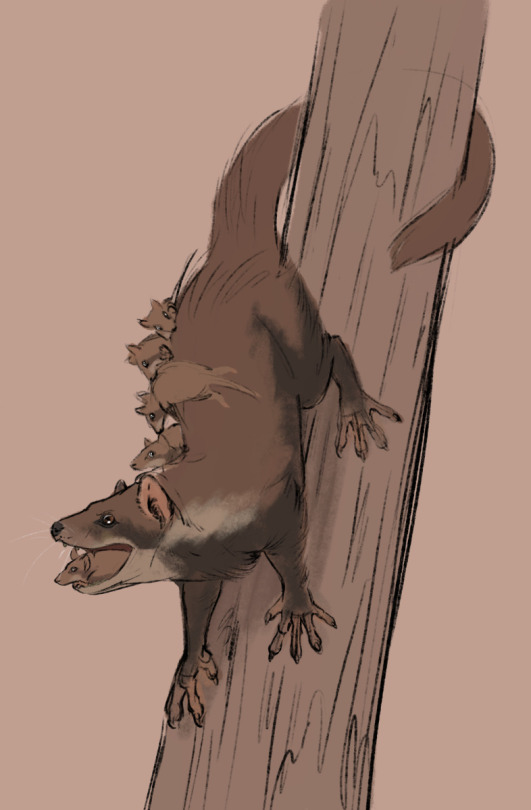
@silverhart-makes-art (link to post here) decided that the best interpretation of the information given was that this was a sort of arboreal mongoose that practiced mouthbrooding. If you want to know what the reasoning was there, you should read the linked post -- it all makes sense there. I absolutely love that the one in the picture is opening its mouth to show the baby riding inside. Silverhart indicates that this is a quicker sketch than usual, but frankly their animal-drawing skills are so good that even a quick sketch is impressive from my perspective.
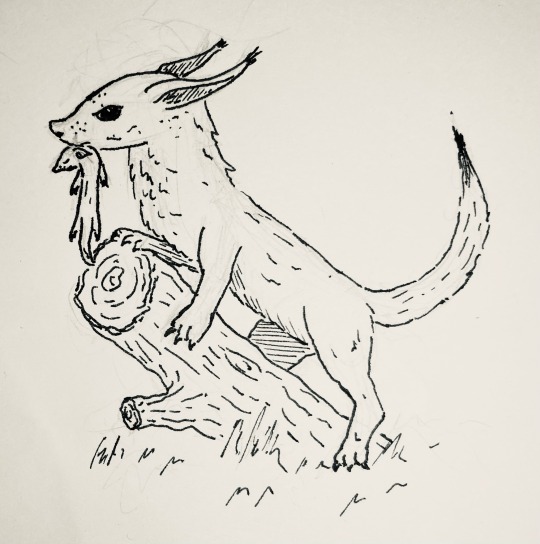
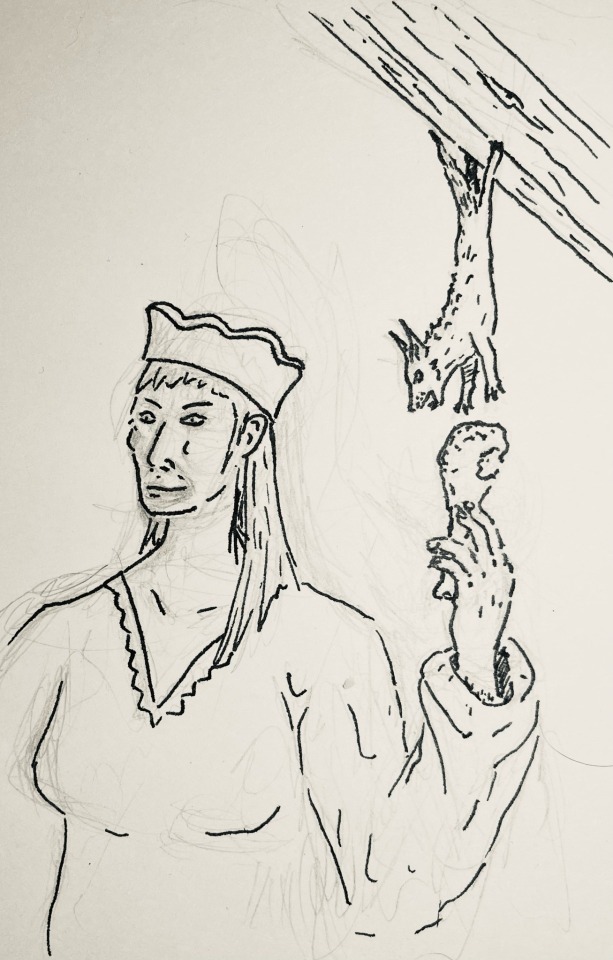
@cheapsweets (link to post here) did separate drawings for the large outdoor version (upper image, carrying its young) and the small indoor version (lower image, stealing someone's food). The linked post, which explains the design in some detail, indicates that CheapSweets was thinking along similar lines as Silverhart -- i.e., what kind of animal is known for hunting snakes? I like the pose in the first image, and I really like the scene depicted in the second one. On one hand, I'm sure having little creatures live in your roof and steal food literally out of your hands is quite frustrating, but on the other hand, it's very funny. Look at that little guy just brazenly stealing some chicken (or whatever type of bird). The idea of them using their back legs to grip rafters for exactly this purpose is excellent.

@strixcattus (link to post here) decided these could be birds, and has drawn these owl-like creatures for us. They look a bit surly, but that could just be the feather pattern on their faces. As always, I strongly recommend checking out that linked post, as Strixcattus writes brilliant interpretations of these entries in the register of a modern naturalist to accompany the illustrations.
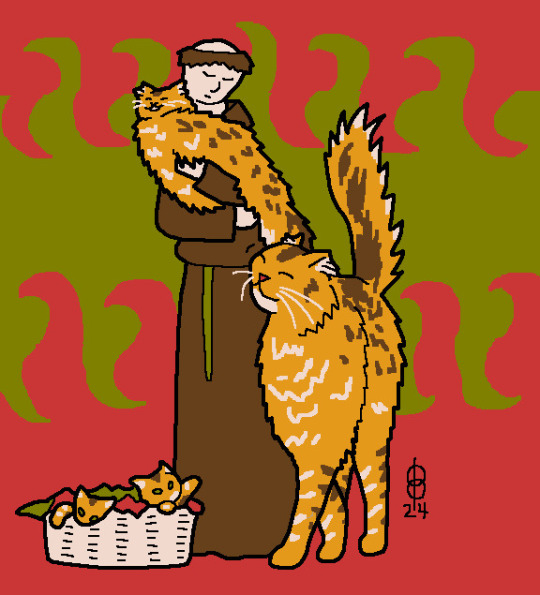
@pomrania (link to post here) has noted that cats live in houses and eat mice, and given us this charming domestic scene. They also note the issues with this interpretation in the linked post, which of course you should read. I think the poses of the cats are very well done here; one of those kittens looks like it wants to paw at the monk's belt but can very much not reach.
And now for the Aberdeen Bestiary:

I'm not sure about the head proportions -- I'd suggest that the flattened snout is because the artist ran out of space, if it weren't for the fact that they were fine letting the back foot extend into the border -- but that is recognizably a weasel.
A few things to note from this:
1. Medieval people apparently had not only mice in their homes, but weasels, which I'd never really thought about. I'm not sure what the distinction they're drawing between the type you find in your home and the type you find in the woods is about, though.
2. The weasel's healing magic crops up in multiple texts, including the Lais of Marie de France and Volsungasaga. It's less common than you might think to find overlap between bestiary-weirdness and narrative-weirdness, so that's pretty notable.
3. I have no friggin' idea why anyone thought they gave birth through their ears. Baffling.
42 notes
·
View notes
Text

I knew I wanted to do Bestiary Posting this week, but I'm gonna be super busy in the coming days, so I had to rush this out right away. So sketch is a bit messy.
At first I thought I knew what critter it could be, but I've been wrong before with my guesses, and then as I started thinking up what I'd like to draw I kept thinking 'oh well, maybe that's what it is; or maybe that's what it is', so suffice it to say, I am not confident in my guess at all.
The Hreksong is cunning and hunts snakes, so my mind went to the mongoose - renowned for it's snake catching skill. Carrying it's young made me think of opossums - in fact a lot of arboreal animals carry their young, so makes sense for it to be arboreal. An arboreal mongoose. The conceiving/birthing through the ears or mouth kind of tripped me up, but I remembered a type of frog that carries it's young in it's mouth, and mouthbrooding is pretty common in fish, so I guess it's not impossible to imagine a more terrestrial animal doing the same (originally did not draw it with an open mouth, and I gotta say the open mouth adds so much charm and horror to this creature; though I am curious if mouth/ear is where it's babies are born/conceived where in the body do they develop? Does it have a womb connected to it's ears/mouth, or is it like a marsupial pouch in the neck? I have so many questions). Of course, being arboreal, it needed reverse counter shading as arboreal animals tend to have. And then it ended up looking like a pine marten. A mouthbrooding pine marten...
Still, I think it would be fun to have your own house Hreksong. The description says they 'roam around in houses', which I can only guess means they are not pets or working animals, and are instead like mice or little brownies that move into your house unannounced, and make mischief in the night. You know, like lapping up all the cream, and stealing only left socks, and mussing up your hair while you sleep. And there's just not a whole lot you can do about it, unless you'd rather be overrun by mice and snakes.
20 notes
·
View notes
Text
The Wily Hreksong
My response to this week’s BestiaryPosting challenge from @maniculum - two pictures this week, the first, the forest-dwelling Hreksong;

The second, the type of Hreksong that lives in your house;

Jinhao shark fountain pen with fine, hooded nib, with Monteverde Raven Noir ink, over initial pencil sketch.
Reasoning below the cut;
"The Hreksong is called [etymology redacted]. It is cunning by nature; when it has produced its offspring in its nest, it carries them from place to place, settling them in a series of different locations. It hunts snakes and mice. There are two kinds of Hreksong. One, of very different size from the other, lives in the forest. The Greeks call these [redacted]; the other roams around in houses. Some say that Hreksongs conceive through the ear and give birth through the mouth; others say, on the contrary, that they conceive through the mouth and give birth through the ear; it is said, also, that they are skilled in healing, so that if by chance their young are killed, and their parents succeed in finding them, they can bring their offspring back to life."
Firstly, what sort of beast is this? We have a mention of ears, so it must be a beast rather than a bird, serpent, or any other type of animal (I know I've used the mention of 'nest' as an excuse to draw more birds before, but I don't think this works in this case!).
They roam around in houses? That means they either they have been domesticated, or they are sneaking around when everyone is asleep (I suppose if they were big and/or scary enough, they might be wandering around when everyone is awake too… it's their house now 😮 ). There's no mention of domestication, and I would hope that there'd be a bit more knowledge about the mating habits of domestic animals (though at this point I feel like the scribes writing these entries are probably terminally obtuse when it comes to sex…). Thus, we have the smaller, urban Hreksong sneaking around the rafters and beams of the house, trying to steal your snacks…
We also have the forest Hreksong, carrying around one of its babies by the scruff of the neck. It has large ears (to give birth out of, I suppose), and as we know this is a fearsome predator of rodents and serpents, so a body plan resembling mustelids or mongooses (not particularly closely related, just convergent evolution into the perfect mammalian body shape!).
This also ties in to what I (now) know of mustelid magic from the Lays of Marie de France…
I really wanted some more practice drawing people (and clothes, oh my goodness clothes are hard!). I'm coming to the conclusion that, to start with at least, less is more; once I'm a bit more confident with the basics, I can start filling in more of the details!
12 notes
·
View notes
Text
The Hreksong

It's been a while since I've taken something that isn't stated to be a bird, probably isn't one at all, and made it a bird anyway just for the fun of it. I'm thinking owl-like for this one, given the diet we're told.
The Hreksong
The Hreksong (genus Hreksong) is a crepuscular bird native to both Europe and North America. All Hreksongs have brown feathers across their bodies and a paler mask across their faces, in addition to sharp hearing and vision adapted for dim light.
The most common species of Hreksong are the Greater Hreksong and the Lesser Hreksong. The Greater Hreksong is found natively in both Europe and North America. It is large in size, with a wingspan of nearly four feet at its greatest, and it constructs nests in the branches of trees. The Lesser Hreksong is only native to Europe, though it has since been introduced to North America as well. It is smaller, with an average wingspan of two and a half feet, though it is not uncommon for individuals to have less than two feet of wingspan. The Lesser Hreksong nests in cavities, and tends to have a preference for human buildings, such as abandoned barns and unsealed attics.
All species of Hreksong are very mobile during the times they are not raising eggs. As soon as the mother's chicks finish hatching, she will carry them in her beak to a new nesting location to escape any predators which may have been scoping out her nest, and from then on until her chicks leave the nest she will repeat the process any time she senses a foreign entity drawing near to her home. If she fails to find an adequate location for a new nest, she will take her rest in the most suitable hiding place she can find, with her chicks tucked into her feathers, keeping watch until the next twilight and moving again when she is once more in her natural element.
Hreksong are carnivores, and their diet consists mainly of rodents and snakes, though they will also eat lizards, frogs, and smaller birds if the need arises. A mother Hreksong takes care in teaching her chicks to hunt, for she will not leave them alone until she sees that they have made a successful kill, at which point she will abandon (and in some cases destroy) the nest in the assurance that her children are now capable of surviving on their own.
8 notes
·
View notes
Text

The Hreksong!
In this week's Maniculum Bestiaryposting Challenge, we again get a list of behaviors, but no concrete description of what the animal might look like.
What we do get is the information that it builds nests and that there are two different types, "of very different size from the other", one of which breaks into houses, the other one of which lives in the forest. They also hunt snakes and mice and might conceive, or give birth, either through their ears or mouths.
I started with the assumption that it needs no description because it's one of those very common animals that everyone has seen before, and that it's not a bird, but does build nests. This immediately made me think of squirrels, and there are actually several types of wild giant squirrels in Southeast Asia! Not quite as big as in my illustration, and all mostly herbivores, but the Bestiary has so far assumed that many different animals are "enemies of snakes", so why not the giant squirrels too? The long fluffy ears are perfect for conceiving or giving birth through, I hope.
The squirrels themselves are based on one of my absolute favorite drawings from the Codex Manesse.
5 notes
·
View notes
Text
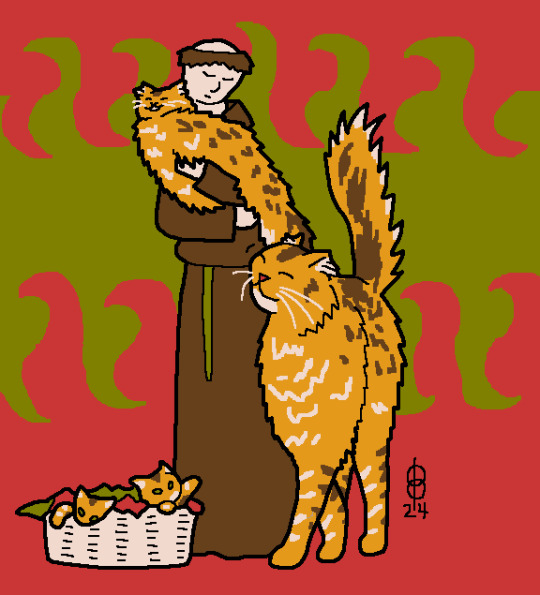
Here's my rendition of the hreksong, from @maniculum's Bestiaryposting. My progress thread for this piece can be found here.
I don't know how I first concluded "these must be cats, in both small and large varieties". It might have been what I'd read as "the smaller ones live in people's houses, eating mice", which would absolutely describe a cat, and then I'd glanced at the word "forest" and thought "Norwegian Forest Cat". Regardless of how it happened in my mind, once I had the idea of drawing Lorge Floofy Kitter, it wasn't like I was going to NOT do that.
If this is in fact referring to the house cat, aka "one of the most domesticated animals out there, for literally millennia", then it wouldn't make sense for the writers to have bizarre misunderstandings of how they reproduce; even today people witness cats mate and give birth, and we live at a substantially farther remove from the life cycles of animals than in the medieval period. However, the interpretation I'm going with for this version of the creature, is that the writer was saying something more like "can you believe what ridiculous ideas some people have about them".
The human in the image is called Brother Mark; I don't know why, that's just the name that came to me. He feels it's his Christian duty to care for all God's creations, and document the beauty and wonder found in every one of them.
12 notes
·
View notes
Text
Bestiaryposting -- Hreksong
As a reminder, all previous entries in this series can be found at https://maniculum.tumblr.com/bestiaryposting .
The Hreksong is called [etymology redacted]. It is cunning by nature; when it has produced its offspring in its nest, it carries them from place to place, settling them in a series of different locations. It hunts snakes and mice. There are two kinds of Hreksong. One, of very different size from the other, lives in the forest. The Greeks call these [redacted]; the other roams around in houses. Some say that Hreksongs conceive through the ear and give birth through the mouth; others say, on the contrary, that they conceive through the mouth and give birth through the ear; it is said, also, that they are skilled in healing, so that if by chance their young are killed, and their parents succeed in finding them, they can bring their offspring back to life.
Remember to tag posts with #Hreksong so folks can find them.
11 notes
·
View notes